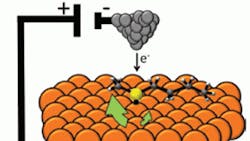Itty-bitty motor seeks Guinness World Record
Scientists at Tufts University, Medford, Mass., have created the first single-molecule electric motor, a feat that could lead to a new class of devices for applications from medicine to engineering. In a paper published online in Nature Nanotechnology, the research team reports an electric motor that measures just 1 nanometer across, significantly tinier than the current world record, a 200-nanometer motor. One strand of human hair is roughly 60,000 nanometers wide. According to E. Charles H. Sykes, Ph.D., associate chemistry professor and the paper's lead author, the team plans to submit the new electric motor to Guinness World Records.
“There has been significant progress in the construction of molecular motors powered by light and by chemical reactions, but this is the first time that electrically-driven molecular motors have been demonstrated, despite theoretical proposals,” says Sykes. “We've shown that one can provide electricity to a single molecule and get it to do something that is not just random.”
Sykes and his colleagues were able to control the motor with electricity by using a low-temperature scanning tunneling microscope, which uses electrons instead of light to see molecules. The team used the metal tip on the microscope to provide an electrical charge to a butyl methyl sulfide molecule on a conductive copper surface. This sulfur-containing molecule had carbon and hydrogen atoms radiating off to form what looked like two arms, with four carbons on one side and one on the other. These carbon chains were free to rotate around the sulfur-copper bond.
By controlling the molecule's temperature, researchers directly impact its rotation. Temperatures around -450° F proved to be best for tracking motor motion and then analyzing the data. However, the motor spins much faster at higher temperatures, making it difficult to measure and control the motor's rotation.
“Once we have a better grasp on the temperatures necessary to make these motors function, there could be real-world application in some sensing and medical devices that involve tiny pipes. Friction of the fluid against pipe walls increases at these small scales, and covering the wall with motors could help drive fluids along,” explains Sykes. “Coupling molecular motion with electrical signals could also create miniature gears in nanoscale electrical circuits. These gears could be used in miniature delay lines, which are used in devices like cell phones.”
For more information, visit tufts.edu.
